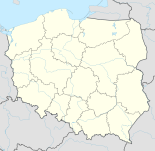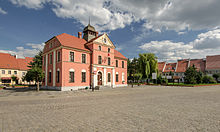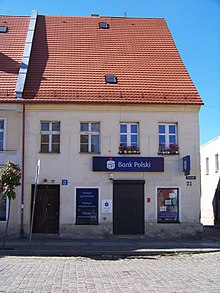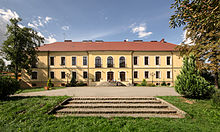Lewin Brzeski
| Lewin Brzeski | ||
|---|---|---|
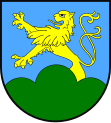
|
|
|
| Basic data | ||
| State : | Poland | |
| Voivodeship : | Opole | |
| Powiat : | Brzeski | |
| Gmina : | Lewin Brzeski | |
| Area : | 10.35 km² | |
| Geographic location : | 50 ° 45 ' N , 17 ° 37' E | |
| Height : | 152 m npm | |
| Residents : | 5823 (December 31, 2016) | |
| Postal code : | 49-340 | |
| Telephone code : | (+48) 77 | |
| License plate : | IF | |
| Economy and Transport | ||
| Street : | Brzeg - Opole / A4 motorway | |
| Rail route : | Opole – Brzeg | |
| Next international airport : | Wroclaw | |
Lewin Brzeski ( German : Löwen ) is a town in the powiat Brzeski in the southern Polish Voivodeship of Opole . Lewin Brzeski, which has around 5800 inhabitants, is the seat of the town-and-country municipality of the same name with a little over 13,000 inhabitants.
Geographical location
The town of Lewin Brzeski is located in the west of the Opole Voivodeship , about 20 kilometers northwest of Opole and 15 kilometers southeast of Brzeg , on the border of the historical region of Lower Silesia and Upper Silesia . The city is located on the left bank of the Glatzer Neisse opposite the mouth of the Steinau . In the north, the community also borders the Oder . The Glatzer Neissetal is characterized by its relatively flat relief. There are wetlands near the river and the surrounding area has to be protected from floods with dykes .
history
Near the transition of the trade route from Silesia to Hungary , the so-called Amber Road over the Glatzer Neisse, Leuven emerged as a market town . This place was first documented in 1257, when the Johanniterkloster Lossen bought a mill and a sales contract was issued. The mint Walter von Lewin , who headed the local mint operated by the Opole dukes , was also mentioned. As early as the middle of the 13th century, the town was granted Magdeburg city rights . A rectangular market square, the Ring, was created in the oval city layout, but Löwen did not have a checkerboard-like floor plan like comparable cities. The city was surrounded by an earth wall with palisades and in front of it a trench could be filled with water from the Neisse through a lock if necessary . There were also four city gates here. In 1333, the town charter and the associated privileges, such as the right to brew and sell beer , and later also the right to hold Wednesday markets , were confirmed by Duke Boguslaus von Brieg , because Leuven had become part of the Duchy of Liegnitz-Brieg and with it fell to Bohemia as early as 1329 .
The 16th century brought an economic boom for the city, in 1526 the city passed to the Habsburgs and since 1592 annual fairs have been held in the city with the permission of the Duke of Brieg . After the Reformation , Löwen became mostly Protestant and the Catholic parish was dissolved. In the Thirty Years' War , the city was looted, burned and the plague struck. In 1742 Löwen became part of Prussia and at that time was a small agricultural town with 700 inhabitants. Several town fires raged in Löwen, the most devastating of which in 1829 completely destroyed the wooden buildings of the town and initiated a fundamental reconstruction of the town. This time stone buildings were erected, of which the classicist town hall from 1837 on the ring is particularly noteworthy.
In 1846, Löwen was connected to the Wroclaw - Opole railway line , which brought about an upswing in the city and the settlement of industry. In 1901 the village of Fröbeln (Wróblin) was incorporated, which had owned a sugar factory since 1882 and had 544 inhabitants in 1895. Administratively, Löwen was part of the Brieg district and the seat of its own local court . A metal factory had existed in the city since 1866, initially producing agricultural equipment, later screws and finally tape recorders . Other important industrial facilities were a brick factory, a roof tile and tile factory and, in addition, a mill. But the streets of the city were also expanded and in 1898 Löwen was connected to Froebel. The old, dilapidated bridge over the Neisse was replaced by a steel bridge in 1913. Since April 7, 1866 there was again a Catholic parish in the city, for which the Marienkirche was later built.
On February 4, 1945, the badly damaged city was occupied by the Red Army . After the expulsion of the German population, Löwen was placed "under Polish administration" , first as Lubień , then as Lewin Brzeski , and initially belonged to the Wroclaw Voivodeship . In 1950 the city became part of the Opole Voivodeship , where it remained after the administrative reform in Poland in 1999.
Population development
The population of the city of Lewin Brzeski according to the respective territorial status. The newer numbers only refer to the city without districts:
|
|
¹ City and municipality: 13,707 inhabitants
² City and municipality: 13,643 inhabitants
³ City and municipality: 13,632 inhabitants
coat of arms
The coat of arms of the city of Lewin Brzeski was adopted on June 18, 1998 and is modeled on a seal from 1333. It shows a golden lion striding to the right over three green hills on a blue background. The lion in the coat of arms refers to the old German name Löwen .
Attractions
- The Löwener Ring is worth seeing , the uniform development of which goes back to the reconstruction after the great city fire of 1829. At that time, simple two-story buildings with steep roofs were built to replace the burned wooden houses. There are also houses from this period in the side streets, some of which were rebuilt after the Second World War.
- At the same time, the town hall was built in 1837 in the classical style on the ring. The simple, rectangular building is two-story and covered with a half-hip roof. Above the main entrance, the town hall has a triangular gable in which the city coat of arms surrounded by stucco is embedded. The roof is crowned by a small roof turret with a simple onion cap .
- The Evangelical Church of St. Peter and Paul is also located near the ring . It dates back to 1312 and has been rebuilt several times since then. In 1534 the church was taken over by the Protestants after it had been remodeled at the beginning of the century. They rebuilt these after a fire in 1586 and extended the building in the Renaissance style. In 1660 the nave and the church tower were rebuilt, which, after being burned out by lightning in 1761, was crowned with a baroque spire. The church was damaged in World War II and the tower was later rebuilt in a simplified form with a Gothic spire.
- Inside the dilapidated and no longer used church, many pieces of Renaissance furnishings have been preserved. The wooden Renaissance main altar from 1613, which was carved by Hermann Fischer from Neisse , is particularly worth seeing . In addition, there is a baroque pulpit in the church and some epitaphs from the 16th and 17th centuries are placed in the choir .
- The neo-Romanesque Catholic Marienkirche was built from 1903 to 1904. The most important work of art is a sandstone altar with a crucifixion scene from the end of the 16th century. It was brought here from its original location in the tower chapel of the Protestant church.
- The baroque castle Löwen was built in 1722 by Otto Leopold von Beeß on two floors in a U-shape. The previous building burned down in 1666. In 1860 a renovation took place, in which a gable was attached over the baroque main portal. After the Second World War, the castle was abandoned, fell into disrepair and burned down in 1955. In 2000 it was completely renovated and given its new use as a high school. The castle grounds are surrounded by a baroque wall with three gates.
local community
The town-and-country community (gmina miejsko-wiejska) Lewin Brzeski extends over an area of 159.7 km² and is divided into 20 villages with school boards in addition to the main town of the same name.
Community partnerships
Lewin Brzeski has partnerships with the following locations:
- Szegvár , Hungary - since 1997
- Senieji Trakai , Lithuania - since 2006
Long-distance transport
Three important east-west connections run through the municipality:
The A4 motorway - the most important east-west transit route in Poland - runs around four kilometers south of the city along the southern border of the municipality. However, there are no direct connection points in the municipality , but only at a distance of over 20 km and outside the municipality. The municipality also has a stake in State Road 94, which connects Wroclaw with Katowice .
Lewin Brzeski station is located on the Bytom – Wrocław railway line, which opened in this section in 1843 .
Personalities
sons and daughters of the town
- Gottfried August Thilo (1766–1855), German engraver, miniature, landscape and portrait painter
- Carl von Plotho (1780–1820), Prussian lieutenant colonel, military historian and writer
- Gustav Hellmann (1854–1939), meteorologist and climatologist
- Hermann Freiherr von Eckardstein (1864–1933), German diplomat
- Martin Schlensog (1897–1987), composer and music teacher
- Dietmar Schicke (* 1942), German politician
Personalities who have worked on site
- Valentin Wojciech (1868–1940), Catholic clergyman and auxiliary bishop in Breslau, at times pastor in Leuven
- Erich Simmel (1885–1974), German lawyer and politician, at times as a lawyer and notary in Leuven
literature
- Lech Szaraniec: Zabytkowe ośrodki miejskie; Górny Śląsk i Małopolska. Muzeum Śląskie, Kattowitz 1996, ISBN 83-85039-52-X (Historic city systems in Upper Silesia and Lesser Poland, including Lewin Brzeski).
Web links
- Official website Lewin Brzeskis (Polish)
- City high school website about Lewin Brzeski (Polish)
- City administration information page (Polish)
Individual evidence
- ↑ See http://www.gemeindeververzeichnis.de/gem1900/gem1900.htm?schlesien/brieg.htm
- ↑ See Michael Rademacher: German administrative history from the unification of the empire in 1871 to the reunification in 1990. brieg.html. (Online material for the dissertation, Osnabrück 2006).
- ↑ http://www.lewin-brzeski.pl/
- ↑ http://www.sbc.org.pl/dlibra/docmetadata?id=808&from=pubstats
- ↑ a b c d e Michael Rademacher: German administrative history from the unification of the empire in 1871 to the reunification in 1990. brieg.html. (Online material for the dissertation, Osnabrück 2006).
- ↑ lions . In: Meyers Konversations-Lexikon . 4th edition. Volume 10, Verlag des Bibliographisches Institut, Leipzig / Vienna 1885–1892, p. 939.
- ↑ http://www.gemeindeververzeichnis.de/gem1900/gem1900.htm?schlesien/brieg.htm
- ^ Heinz Rudolf Fritsche: Schlesien Wegweiser , Bechtermünz Verlag, Augsburg
- ↑ a b c http://www.stat.gov.pl/
- ↑ See [1]
